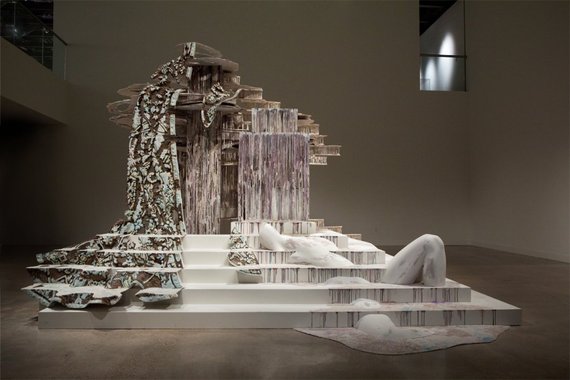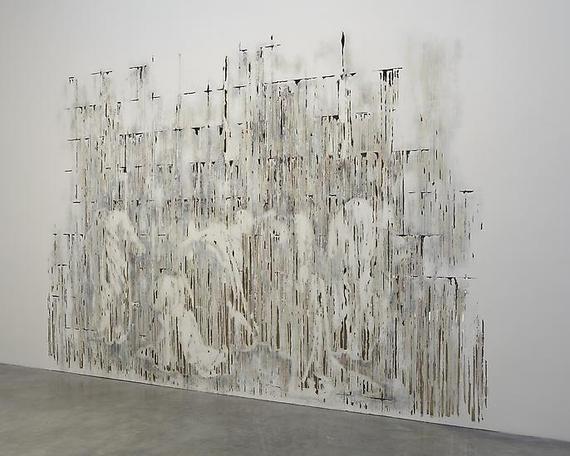Diana Al-Hadid's monumental sculptures and panels are classically crafted, yet ephemeral. Built up from paint and plaster remains they appear hollow, almost broken, toying with our conception of space and gravity. Her exhibition "Regarding Medardo Rosso" is currently up at at Marianne Boesky's 64th Street location. We visited the artist in her studio in the weeks leading up to her show to talk about the new work on view.
Tell me about your show at the Marianne Boesky Gallery.
DIANA AL-HADID: It's mostly my work, and there will be one sculpture by Rosso. I'm a big fan of his work, and my gallery proposed showing my work in context with his. His work resonates with me and in some ways, is inspired by his. I only came across his work when I did a show in 2011 at the Nasher Sculpture Center and they had a couple of his small wax heads. I was very taken with them.
You also do head sculptures.
DAH: I was already working on them, and something about his work spoke to me. I don't know that it directly influenced me but it resonated with my process. I thought it would be interesting to think of him as I'm making this new body of work, and reincorporating some of the bronze heads I used into newer sculptures. He would do similar things like reuse original cast of his sculptures. I get attached to the process and the materials, and I like discovering different ways the material might misbehave, and peripheral cast-off elements that get slapped back into the sculpture.
I read you start out with materials rather than an idea. In one series you closed your eyes while you sculpted the busts.
DAH: For that series, the busts, it was an effort to trick my mind out of the usual order of thinking. I wanted to free my mind from "decisions" and work without looking. There weren't conscious decisions to make. I wasn't looking, thinking, interpreting; I was just acting. It was liberating, because I didn't have to concentrate on a particular subject, I could just think about the materials and the pressure of my hands, the skin, and not the particulars of identity. I think a lot of sculptures have a similar feel; the "who" is not so important. What draws people is the process of the materials, the ways he innovated or interpreted his materials.
What is that material?
DAH: It's the same plaster I always use, reinforced with fiberglass. I drew it on a flat surface, reinforced it, and stood it up. I like to thin as much of the body as possible. Here you'll see a drawing on a cloak, then when you walk around you see more of the substance that's illustrated on the one facet of the sculpture, and you kind of have to walk around it to learn more.
What is it like to switch between mediums?
DAH: The panels are pretty new to me. I've been doing them two or three years. Three years ago I was experiencing with this specific process. They came as a result of the sculpture, and process. Some of the images are architectural, but more than that I learned how to thin the structures out. I want to make them as liquid and transparent as possible, before they fall apart. So when I make these paintings, they are all built one drip at a time. There's no canvas, its painted on and done additively. I'll paint it in reverse, and then I'll reinforce the drips of color. The color is embedded into the plaster (like a fresco) and peels off the wall, and the result is what remains. It's kind of trying to dissolve the image and the structure and challenge the plane as much as possible.
I'm always drawing in conjunction with my sculptures, but I've never thought of myself as a painter. It's hard for me to call these paintings. This happened after ten years of messing with sculptural elements. I go between mediums simultaneously. Sometimes I'll work on something for a few hours and move on. In the past I didn't know how to do that. Now I have a lot of work cooking at once.
Do you enjoy that?
DAH: It's healthy for me at the moment. It helps teach me about the process in different forms, I get to experiment more quickly. All my efforts aren't concentrated in one place.
Would you say one theme throughout your work is deterioration?
DAH: I like to laminate the structure and the skin has always been important to me. It's interesting to say they're deteriorating, because they're all built up. They start from nothing. So it's not like I'm stripping away material, although there's a lot of add and subtract. A lot of how it looks comes from my compulsion to thin out the sculptures as much as possible and have the work be something you can see through, and walk around. There's a lot of physical battling and tearing up of the work; sometimes I'm cutting off a limb of something. It's more improvised than one might realize. Maybe it's a little deceptive, because it looks like something that's cut away, but it's the opposite. I think the examination of the process, realizing it wasn't made the way you thought it was, is interesting. It's interesting to see how people interpret or assume its been made.
Diana Al-Hadid: Regarding Medardo Rosso" will be at the Marianne Boesky Gallery at 118 E. 64th St. through March 19.
This article was originally published on Whitewallmag.com. Read the full article here.

